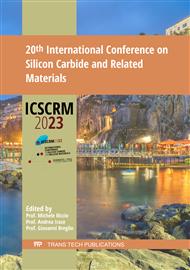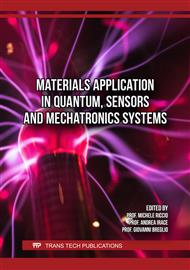[1]
Y. Bai, T. Xu, X. Zhang, Graphene-Based Biosensors for Detection of Biomarkers. Micromachines. 11 (2020) 60-72.
Google Scholar
[2]
Y. Xiao, Y.X Pang, Y. Yan. P. Qian, H. Zhao, S. Manickam, T.Wu, C.H. Pang, Synthesis and Functionalization of Graphene Materials for Biomedical Applications: Recent Advances, Challenges, and Perspectives, Adv. Sci. 10 (2023) 2205292.
DOI: 10.1002/advs.202205292
Google Scholar
[3]
S. Wang, X. Qi, D. Hao, Review—Recent Advances in Graphene-Based Field-Effect-Transistor Biosensors: A Review on Biosensor Designing Strategy. J. Electrochem. Soc. 169 (2022) 027509.
DOI: 10.1149/1945-7111/ac4f24
Google Scholar
[4]
R.M. Torrente-Rodriguez, H. Lukas, J. Tu, et al. A Graphene-Based Multiplexed Telemedicine Platform for Rapid and Low-Cost COVID-19. Nat. Biotechnol. 38 (2020) 217.
Google Scholar
[5]
A.A. Lebedev, S.Y. Davydov, I.A. Eliseyev, et al. Graphene on SiC Substrate as Biosensor: Theoretical Background, Preparation, and Characterization. Materials 14 (2021) 590.
DOI: 10.3390/ma14030590
Google Scholar
[6]
N.M. Shmidt, A.S. Usikov, E.I. Shabunina, et al. Investigation of the morphology and electrical properties of graphene used in the development of biosensors for detection of influenza viruses. Biosensors 12 (2022) 8-26.
DOI: 10.3390/bios12010008
Google Scholar
[7]
Z. Tehrani, G. Burwell, M. A. Mohd Azmi, Generic epitaxial graphene biosensors for ultrasensitive detection of cancer risk biomarker. 2D Materials 1 (2014) 025004.
DOI: 10.1088/2053-1583/1/2/025004
Google Scholar
[8]
I.A. Eliseev, E.A. Gushchina, S.A. Klotchenko, et al. Modification in adsorption properties of graphene during the development of viral biosensors. Semiconductors 56 (2022) 908.
Google Scholar
[9]
A. Choi, A. T. Hoang, T. T. Ngoc Van, B. Shong, et al. Residue-free photolithographic patterning of graphene. Chem. Eng. J. 429 (2022), 132504.
DOI: 10.1016/j.cej.2021.132504
Google Scholar
[10]
S.-W. Lee, M. Muoth, T. Helbling, M. Mattmann, C. Hierold Suppression of resist contamination during photolithography on carbon nanomaterials by a sacrificial layer. Carbon 66 (2014) 295.
DOI: 10.1016/j.carbon.2013.09.003
Google Scholar
[11]
S. Eissa, J.G. Contreras, F. Mahvash, et al. Functionalized CVD Monolayer Graphene for Label-Free Impedimetric Biosensing. Nano Res. 8 (2015) 1698–1709.
DOI: 10.1007/s12274-014-0671-0
Google Scholar
[12]
V. Georgakilas, M. Otyepka, A. B. Bourlinos, et al. Functionalization of Graphene: Covalent and Non-Covalent Approaches, Derivatives and Applications. Chem. Rev. 112 11 (2012) 6156−6214.
DOI: 10.1021/cr3000412
Google Scholar
[13]
A.C. Ferrari, D.M. Basko, Raman spectroscopy as a versatile tool for studying the properties of graphene. Nat. Nanotechnol. 8 (2013) 235–246.
DOI: 10.1038/nnano.2013.46
Google Scholar
[14]
F. Fromm, M. H. Oliviera Jr., A. Molina-Sanchez, et al. Contribution of the buffer layer to the Raman spectrum of epitaxial graphene on SiC(0001). New J. Phys. 15 (2013) 043031.
DOI: 10.1088/1367-2630/15/4/043031
Google Scholar
[15]
A.A. Balandin, Low-frequency 1/f noise in graphene devices. Nature Nanotechnology 8 (2013) 549-555.
DOI: 10.1038/nnano.2013.144
Google Scholar
[16]
I.A. Eliseyev, A.S. Usikov, S.P. Lebedev, et al. Raman scattering and low-frequency noise in epitaxial graphene chips. J. Phys.: Conf. Ser. 1697 (2020) 012130.
DOI: 10.1088/1742-6596/1697/1/012130
Google Scholar
[17]
I. Novodchuk, M. Bajcsy, M. Yavuz, Graphene-Based Field-Effect-Transistor Biosensors for breast canser detection: A review on biosensing strategy. Carbon 172 (2021) 432-453.
DOI: 10.1016/j.carbon.2020.10.048
Google Scholar



